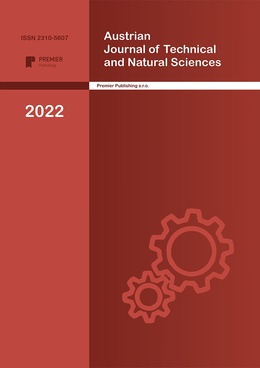DETERMINATION OF FLAVONOIDS IN DIFFERENT OILS OF CANNABIS SATIVA L (CANNABACEAE) AND EVALUATION OF PHYSICO-CHEMICAL INDICATORS
Authors
Mamadaliev Asilbek N., Kushiev Khabibjon Kh., Abdullaeva Zaynab R.

Share
Annotation
The article presents the results of studies of the flavonoid composition of cold-pressed hemp oil, implemented in the trade network of the Republic of Uzbekistan by chromatographic methods, as well as the results of assessing their quality characteristics, verified according to ISO requirements. In the analysis of 5 samples of hemp oils (Cannabis sativa L), 3 samples were found, which, in terms of the quantitative content of quercetin, rutin and gallic acid, are higher than the rest. Among the studied 5 samples of cold-pressed hemp oils, moisture, peroxide value, acid value according to ISO was also determined. In this regard, it follows that in the production and use of cold-pressed hemp oils, it is necessary to constantly monitor moisture, peroxide value, and acid value. Detailed information on flavonoids can be obtained with the complex application of chromatographic methods of analysis.
Keywords
Authors
Mamadaliev Asilbek N., Kushiev Khabibjon Kh., Abdullaeva Zaynab R.

Share
References:
1. Mamadaliev A.N., Kushiev Kh.Kh., Bekpulatov Kh., Abdullaeva Z.R., “Determination of the amount of flavonoid in industrial hemp and licorice grown in Uzbekistan, using a high-performance liquid chromatograph the role of flavonoids in the pharmacopoeia” Научный журнал Universum: химия и биология. 2021. 77-81 page. DOI - 10.32743/UniChem.2021.87.9.12230
URL: https://7universum.com/ru/nature/archive/item/12230
2. Vengerovsky A.I., Saratikov A.S. The mechanism of action of hepatoprotectors in toxic liver damage // Pharmacology and toxicology. - 1988. No. 1. - pp. 89-94
3. Korulkin D.Yu., Abilov Zh.A., Muzychkina R.A., Tolstikov G.A. Natural flavonoids. Novosibirsk: Academic publishing house “Geo”, 2007. –p. 232
4. Kurkin V.A., Pravdivtseva O.E. St. John’s Wort: Results and Prospects for the Creation of Medicines: Monograph. Samara: GOU VPO “SamSMU”; LLC “Etching”, 2008. –p. 127
5. Kurkin V.A. Fundamentals of herbal medicine: A textbook for students of pharmaceutical universities. - Samara: OOO “Etching”, GOU VPO, SamSMU Roszdrav, 2009. - 963 p.
6. Mamadaliev A.N., Kushiev Kh.Kh., Abdullaeva Z.R., Djuraev T.A., “Dynamics of change in the elemental composition of technical hemp varieties in the soil-plant system, grown in the conditions of the Syrdarya region” IOP Conference Series: Earth and Environmental Science. 2022
7. Kurkina A.V. Flavonoids of pharmacopoeial plants: Monograph. - Samara: OOO “Etching”; SBEE VPO SamSMU Ministry of Health and Social Development of Russia, 2012. –p. 290
7. Tamura M, Nakagawa H, Tsushida T, et al. Effect of pectin enhancement on plasma quercetin and fecal flora in rutin-supplemented mice. J FoodSci 2007;72: S648-S651.
8. Matsukawa N, Matsumoto M, Shinoki A, et al. Nondigestible saccharides suppress the bacterial degradation of quercetin aglycone in the large intestine and enhance the bioavailability of quercetin glucoside in rats. J Agric Food Chem 2009; 57:9462-9468.
9. Erlund I, Freese R, Marniemi J, et al. Bioavailability of quercetin from berries and the diet. Nutr Cancer 2006; 54:13-17.
10. Erlund I, Marniemi J, Hakala P, et al. Consumption of black currants, lingonberries and bilberries increases serum quercetin concentrations. Eur J Clin Nutr 2003; 57:37-42.
11. Scholz S, Williamson G. Interactions affecting the bioavailability of dietary polyphenols in vivo. Int J Vitam Nutr Res 2007; 77:224-235.
12. Gregory S. Kelly ND. Quercetin. AMR 2011; 16:2: 172-94.
13. Bhutada P, Mundhada Y, Bansod K, et al. Reversal by quercetin of corticotrophin releasing factor induced anxiety- and depression-like effect in mice. Prog Neuropsychopharmacol Biol Psychiatry 2010; 34:955-960.
14. Singh A, Naidu PS, Kulkarni SK. Quercetin potentiates L-Dopa reversal of drug-induced catalepsy in rats: possible COMT/MAO inhibition. Pharmacology 2003; 68:81-88.
15. Kambe D, Kotani M, Yoshimoto M, et al. Effects of quercetin on the sleep-wake cycle in rats: involvement of gamma- aminobutyric acid receptor type A in regulation of rapid eye movement sleep. Brain Res 2010; 1330:83-88.
16. J Jeong, J An, Y T Kwon, J G. Rhee, YJ. Lee. Effects of low-dose quercetin:cancer-specific inhibition of cell cycle progression. J Cell Biochem. 2009 January 1; 106(1): 73–82.
17. Mamadaliev A.N., Kushiev Kh.Kh., Komilov A.A. “Comparative chemical analysis of non-drug varieties of Cannabis Sativa L. Grown in saline soils of the regions” Научный журнал Universum: химия и биология. 2021. 77-81 page.
DOI: 10.32743/UniChem.2021.86.8.12136
URL: https://7universum.com/ru/nature/archive/item/12136
18. Mamadaliev A.N., Kushiev Kh.Kh., “Определение протеина в составе технической конопли по методу Къельдаля” The Journal of Academic Research in Educational Sciences.2021 23 page. DOI: 10.24412/2181-1385-2021-8-4-10
URL: http://www.ares.uz/uz/jurnallar-sahifasi-eski/ares-vol-2-no-8-2021


